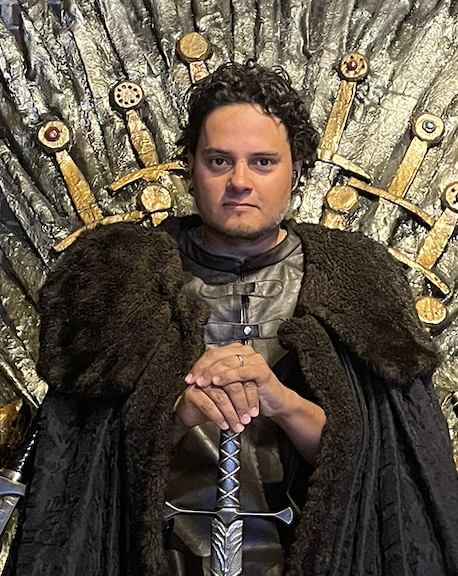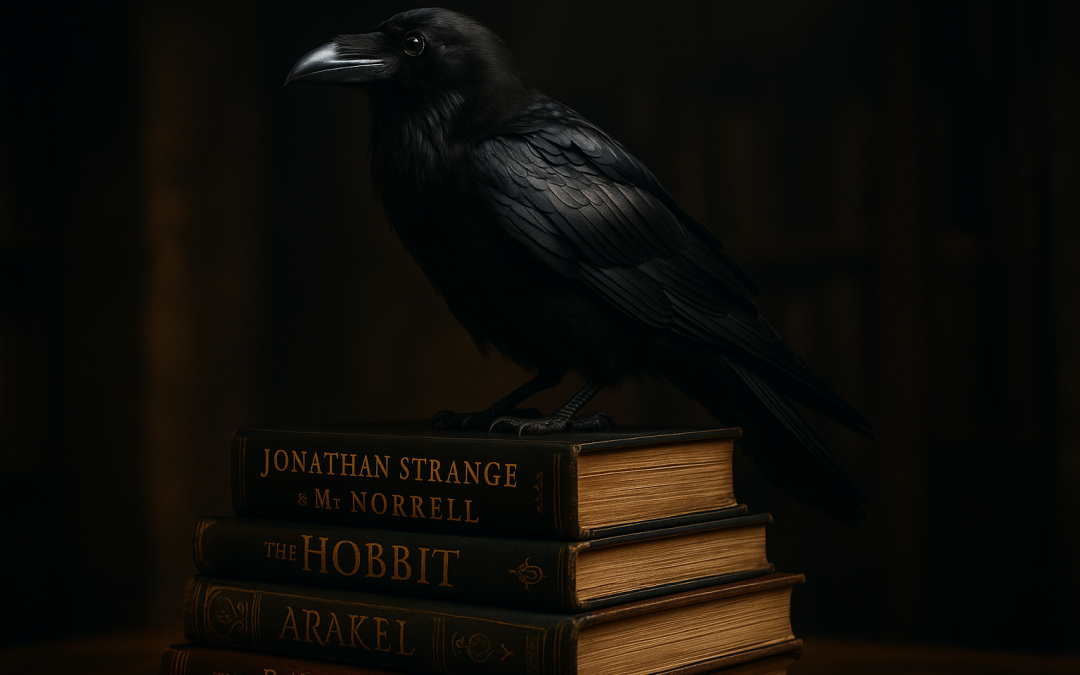Ever noticed how fantasy novels practically invite ravens in? They’re everywhere.
From mossy woods to neon-lit city streets packed with magic.
And yep, that’s not just your imagination. These black-feathered tricksters tap into centuries of myth, symbolism, and sometimes, straight-up gothic vibes.
Since my own novel, Son of the Axe, has a raven in it, I decided to look at how this creatures has been used in fiction, from old-school myth, epic sagas, and, my personal favourite, urban fantasy. Because, let’s face it, when a raven lands on a streetlamp in a modern city, you know the mundane just got mystical.
Old World Omens and Mythic Ravens (Classic Inspirations)
Let’s wander back to when fantasy got its wings—ancient myths, gothic poetry, and battlefield omens—because that’s where the raven really carved out its legacy.
1. Odin’s Feathered Spies
In Norse myth, Odin literally outsourced his premonitions to two ravens: Huginn (“Thought”) and Muninn (“Memory”)—they fly across the world and whisper back everything they’ve seen and heard. It’s why Odin earned the nickname “raven-god”—and why ravens in fantasy often feel like messengers of the gods or secret-keepers.
2. Ravens on the Battlefield
Across Celtic myth, ravens also play dramatic roles. The Morrígan, a war and fate goddess, frequently takes the form of a raven (or crow) on battlefields, delivering omens—sometimes doom, sometimes guidance—through her sharp cries and presence. Another figure, Badb, is known to scream as a raven among corpses, stirring fear or prophecy, depending on the tale.
3. Raven Banners & Viking Symbols
Ravens weren’t just mythical—they were woven into flags, too. Viking chieftains flew raven banners, believed to channel Odin’s power and strike terror into foes. Across those cultures, battlefield imagery of ravens became a poetic shorthand for death, prophecy, and the divine watching over battle.
Why does this matter to fantasy readers? Ravens in modern stories lean on these mythic roots. Whether they’re watchers, omens, or familiars, when a raven appears in a tale (especially around conflict or magic) it’s not random. It’s echoing centuries of lore where ravens carried thought, memory, and destiny across mortal and divine realms.
Dark Wings in Epic and Dark Fantasy
Let’s look at the more shadowy side of fantasy, where ravens don’t just show up, but fly in with secrets, omens, and occasionally, prophecies.
Tolkien’s Middle-earth: Roäc and the Crebain
In The Hobbit, there’s the decrepit but wise raven Roäc, son of Carc, perched atop Ravenhill near Erebor. He brings Thorin and company news of Smaug’s death, warns that “the treasure is likely to be your death,” and even carries a message requesting reinforcements from Dáin—mixing messenger duties with a bit of sage advice along the way.
On the darker side, The Lord of the Rings introduces the Crebain—crow-like scavengers serving as spies for sinister forces. A flock of these winged watchers is often a telltale sign that enemies lurk nearby, using birds to rat out—or rat—out presence.
George R.R. Martin’s Westeros: From Mail-Carriers to Mystics
In A Song of Ice and Fire, ravens are the go-to messengers, the postal service of Westeros. “Dark wings, dark words” often deliver grim tidings.
Then there’s the mystical turn: the Three‑Eyed Raven (or Three‑Eyed Crow in the books)—a greenseer who guides Bran through visions and time, offering wisdom from beyond realms and memories. Some scholars even note echoes of Celtic raven myths, particularly the layered symbolism of the Morrígan, in this enigmatic figure.
Why does it matter for readers like us? In epic and dark fantasy, ravens aren’t just birds—they’re literary shortcuts packing myth, mood, and meaning. If a raven shows up, get ready for something significant: news, forewarning, or something beyond mortal sight. It’s not just worldbuilding; it’s a nod to ancient lore wrapped in wings.
Urban Fantasy’s Winged Watchers
In urban fantasy, ravens don’t just bring magic—they are magic, blending ancient myth with modern grit.
Neil Gaiman – Myth in the City
Urban fantasy loves to bring ancient symbols into modern streets, and Gaiman does this in style. In American Gods, we meet a grizzled incarnation of Odin traveling America – of course accompanied by his two raven pals, casually introduced as “my ravens are Huginn and Muninn, Thought and Memory”.
These birds tie the contemporary setting back to Norse myth, acting as Odin’s eyes even amid highways and neon lights. And in Gaiman’s Sandman (graphic novel meets urban fantasy), Dream of the Endless has a raven sidekick (Matthew) who serves as a messenger between human dreams and the divine.
Gaiman’s ravens blend the everyday with the supernatural: a touch of old gods’ magic perched on a city streetlamp.
Charles de Lint – Folklore in the City Streets
De Lint, often called the grandfather of urban fantasy, frequently weaves animal spirits and folk legends into his modern tales, and ravens are a recurring motif.
His novel Someplace to Be Flying features the Crow Girls, two puckish young women who are actually ancient crow–spirit tricksters hanging out in present-day Newford. They drop truth bombs in conversation “sometimes the way mischievous children would and sometimes the way ancient trickster gods would”.
In the same book, there’s also a character who embodies Raven himself (a First People deity figure) and even a legendary “Raven’s pot” that can remake reality.
De Lint’s urban fantasies show ravens as tricksters and storytellers, bridging the gap between mundane city life and the mystical First Nations legends. It’s a geeky delight for those who catch the mythic references!
Seanan McGuire – Modern Magic and Raven Nods
Seanan McGuire’s works (like the October Daye series and InCryptid series) are chock-full of fairy tale and folklore creatures in contemporary settings. While her primary characters might be fae or cryptids, ravens aren’t far behind as symbols. In fact, McGuire even titled one of her InCryptid short stories “White as a Raven’s Wing,” a nod to raven imagery in a modern paranormal context.
Throughout urban fantasy, authors use ravens and crows to signify that the city isn’t so secular… the old myths are alive and perched overhead. Whether it’s a literal bird spying from a telephone pole or a raven emblem in a shop window, the presence of a raven in urban fantasy often hints that magic is watching, even in the heart of the concrete jungle.
Ravens in Historical Fantasy
Historical fantasy (which blends magic with real historical settings) often leans on raven lore to add an air of antiquity and mystery.
A great example is Susanna Clarke’s Jonathan Strange & Mr Norrell, set in an alternate Napoleonic-era England. The legendary John Uskglass, aka the Raven King, once ruled the North and left behind prophecies – and when he finally stirs, he heralds it with a literal storm of ravens. (One of his signature magical feats is the “Chaos of Ravens,” conjuring a flock of ravens from thin air to do his bidding–now that’s making an entrance!) By invoking ravens, Clarke ties her fantasy England to medieval legend and creates a haunting, otherworldly vibe.
Historical fantasies also love to reference the Tower of London ravens myth mentioned earlier. For instance, if you’re writing a Victorian-era fantasy, throwing in a line about the ravens of the Tower (and maybe a nervous guard ensuring they don’t fly away) instantly grounds the story in real legend. It reminds readers of a time when people truly believed a kingdom’s fate hung on a few black birds.
Authors in this subgenre use ravens as guardians of the crown, omens during wartime, or companions to sorcerers at court… all ways to signal that the magic in their alt-history is intertwined with actual folklore. In historical fantasy, a raven on the battlefield or palace roof is a nod that history itself has a soul, and it might be a big black bird.
Evermore, the Raven Remains
Ravens in fantasy are far more than background birds. They’re emblems of the genre’s heart. They carry the shadows of death and the light of insight in equal measure, symbolizing that blend of danger and knowledge that fantasy so often explores.
Across classic epics, grimdark sagas, urban thrillers and historical epics, the raven’s role is always a signal that something deeper is at play: ancient magic, prophecy, or the hand of fate itself.
Fantasy readers are a geeky bunch who love our symbols and Easter eggs, and the raven, with its mystique from myth and presence in pop culture literature, delivers on both fronts.
Like a good omen (or a bad one!), the raven keeps coming back to our pages, never truly saying “Nevermore.”

D.P. Martinez is a contemporary fantasy author specialising in urban fantasy and magical realism. He holds an M.A. in English Literature from the University of Greenwich, where he focused on Literary London. His research explored metaphorical representations of London in urban fantasy. He has written hundreds of articles and several books across both fiction and non-fiction.

